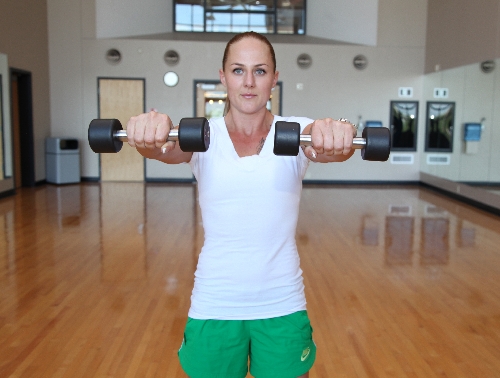Controlled moves will help you build stronger shoulders

Want to see some killer shoulder stability? Watch Olympic gymnasts perform their routine on the rings. As a trainer, I see an intense stability and strength regimen culminating in a display of sheer control.
Think about it, have you ever seen an Olympic gymnast not in control? Even when they are swinging and flipping on the rings, they are in complete control. Those movements have to be practiced and perfected on all levels; from total body all the way down to isolation training.
Generally, isolating shoulder muscles helps sculpt the ideal physique whether your goal is to have large, well-defined shoulders like an Olympic gymnast or lean shoulders like a dancer.
Isolating the different muscles of the shoulder also helps strengthen the rotator cuff. The shoulder joint is similar to the hip in that it has a large degree of rotation compared with joints like the elbow or knee.
If any of the deltoid or rotator cuff muscles are weak or tight, then the shoulder joint could be compromised when lifting heavy or awkward loads. In short, isolated movements will help improve big lifts. This is why form and shoulder stability are important.
When isolating individual muscles one goal is to ensure full range of motion and proper muscle recruitment. Shoulders are notorious for improper recruitment. This can be because of incorrect spinal position, poor execution of various exercises or an injury.
Controlling movements is crucial. The complex of muscles that make up the shoulder is significantly smaller than other muscle groups. Small muscles lift smaller weights.
Guys, doing shoulder raises with the 5- and 10-pound dumbbells does not decrease your macho level. Correct isolation movements, using manageable weights, will aid in better total body movements.
Injury can cause decreased strength or performance. Shoulder injuries plague many people. They could start with a strain that hasn’t had time to heal properly. That compounds into altered muscle recruitment and eventual constant pain.
Another cause could be that the muscle has suffered an intense trauma, which also can be painful. Various occupations that require repetitive motions can lead to injury.
Injuries can differ in how they feel. Some injuries hurt only when the muscle is used. Others hurt all the time. Some shoulder injuries can hurt only when pushing, pulling or rotating.
These feelings may signal something as simple as inflammation or knotted muscles. Other injuries can be as complex as tears and/or cartilage damage. When in doubt, check it out. See a physician, and get whatever scans will help determine your precise issue.
Today’s exercises are isolation movements for the shoulders. Swinging the dumbbells is a common mistake in these movements. If you’re swinging weights, you’re not in control.
Having the core activated is a necessity. The back tends to arch if the core is not tight. Performing exercises with an unstable spine eventually will lead to injury.
Lastly, keep the entire back straight. If the upper back is slouched forward then the spine is not in a stable position. Squeeze the shoulder blades together to lock the back in a good position. Repetition ranges are 10 to 15 reps for two to four sets for each of the three exercises.
If you’re not used to shoulder isolation, performing all of these exercises in one day will definitely make your shoulder muscles sore. My advice is to start off with one set of each exercise and work up from there.
Chris Huth is a Las Vegas trainer. You can contact him at702trainer@gmail.com. Before beginning any exercise program, consult your physician.